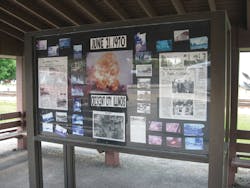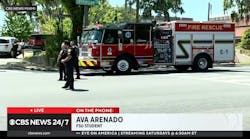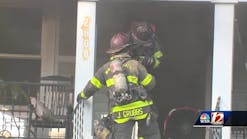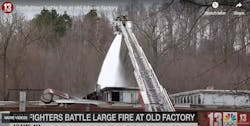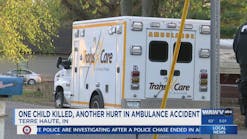It was Father's Day, June 21, 1970, a peaceful Sunday in Crescent City, IL. At 6:30 A.M., a young girl delivered newspapers, Firefighter Bill Dirks was asleep in his apartment above stores on Main Street and Fire Chief Orvel Carlson was awake at his residence. Little did they know that a derailment involving 16 cars of the 109-car eastbound Toledo, Peoria and Western Railroad Co. Train No. 20 was about to shatter their peace.
Ten of the railcars involved in the derailment each contained 34,000 gallons of liquid propane. Two additional propane railcars remained on the tracks. As a result of the derailment, one of the propane tank cars was punctured by a coupler of another car, causing a leak that ignited almost immediately, engulfing the other nine derailed propane cars. Flame impingement on the uninsulated tank cars caused an increase in pressure inside the tank cars from impingement on the liquid space. Impingement on the vapor space caused weakening of the steel that resulted in the BLEVEs (boiling liquid expanding vapor explosions) that occurred.
Carlson felt heat from the initial explosion at his home three blocks away. The girl delivering newspapers was burned by the heat. Dirks, awakened by the explosion, said, "It took 10 years off my life." Dirks, who had been on the department for three years at the time of the derailment, is still an active firefighter in Crescent City, 40 years after the derailment.
Carlson and the 20-member Crescent City Volunteer Fire Department (two members were out of town) responded quickly with their two pieces of fire apparatus, 1956 and 1961 International Harvester front-mounted, 500-gpm pumpers (in service today as brush fire units). The Crescent City firefighters initially tried to contain the fire burning intensely around the railcars, but were hampered by a lack of electricity after power was knocked out by the derailment, preventing the city's water pumps from functioning. Firefighters took water directly from the city water tower to fight the fire until help arrived from other communities. Water was hauled by privately owned tractor-trailers from surrounding towns and other fire departments also responded with tankers.
Calls for assistance went out to several area fire departments and many other departments responded to the scene on their own. Ultimately, fire companies from 33 towns (some from as far away as Indiana) appeared with 58 pieces of equipment and 250 firefighters. There were no radio communications between fire departments at the time of the derailment or between fire and police departments. Apparatus did not have radios and no portable communications equipment existed for fire department use. Chanute Air Force Base in Rantoul sent a foam truck. They informed the local firefighters that water would be unable to contain such a fire that included burning propane.
An Illinois State Police sergeant in Watseka, about six miles east of Crescent City, was notified of the derailment shortly after it happened and proceeded immediately to the scene. He arrived at approximately 6:45 A.M. and sized up the situation. When he determined that a tank car was being heated by the fire and contained propane, he notified police officers in the area to evacuate the town and warned firefighters to move back to a safer location to fight the fires. His actions may have prevented serious injury and loss of life of firefighters, police officers and civilians when the propane tank cars started exploding.
Flames from the first punctured tank car reached several hundred feet into the air, dwarfing the Crescent City water tower and impinging on the other propane tank cars. A nearby house and business were set on fire by radiant heat, injuring several residents. Because of the dangers of the burning propane and tanks being heated by the fires, Crescent City was evacuated and people remained out of their homes and businesses for 36 hours.
Relief valves on the other tank cars began to open as the pressure built up from the surrounding fires. The first BLEVE occurred at 7:33 A.M., nearly an hour after the derailment. The first blast injured several firefighters and bystanders and damaged some fire equipment. Additional explosions occurred at about 9:20, 9:30, 9:45, 9:55 and 10:10. The remaining propane tanks were allowed to burn, which lasted for 56 hours. Parts of tank cars were propelled in all directions, setting fires and damaging structures. In all, 10 large pieces of railcars rocketed from 200 feet to 850 feet from the derailment site. There were no serious injuries to civilians initially from the explosions, because of a quick evacuation after the derailment; 66 people (fire, police and press personnel) were injured by the explosions and 11 required hospitalization, but there were no fatalities. Some civilians were injured when they returned to town to watch the fire.
Few of the responding firefighters had any training in dealing with propane fires. Some of the injured firefighters were not wearing their personal protective clothing. Others sustained burns to their hands and heads when helmets were blown off by the force of the explosions. Firefighters had no hand protection and their plastic helmets had no ear protection or chin straps. It was reported that the force of one of the later explosions blew out building fires on Main Street, but as oxygen returned, the fires reignited.
Twenty-five homes and 16 businesses were destroyed by fire and three destroyed by "flying" tank cars; numerous other homes received damage. St. Joseph's Church sustained extensive damage. More than $2 million in property damage occurred as a result of the derailment, fires and explosions. Six fire trucks were damaged by the explosions and fires, along with 3,050 feet of 2½-inch fire hose, 500 feet of 1½-inch hose, several ladders, nine firefighter coats and seven firefighter helmets. Warning lights on Crescent City pumpers melted and apparatus had to be repainted. According to the National Transportation Safety Board (NTSB), overheating caused the breaking of the L-4 Journal of the 20th car in the train. The exact cause of the overheating was not determined, but a motorist spotted smoke coming from one of the railcars when the train was approximately 10 miles west of Crescent City.
After several BLEVEs of this type occurred in the 1970s, the railroad industry retrofitted all tank cars carrying liquefied flammable gases by adding thermal protection, which protects against high temperatures that can weaken metal. Shelf couplers were developed to prevent cars from uncoupling vertically and head shields were fitted to protect against punctures from the couplers. Since these retrofits were completed in 1980, there have been no BLEVEs of railroad tank cars in the United States.
In the 1970s, organized hazardous materials response by fire departments and other agencies began to develop. Significant incidents involving railroad tank cars in Waverly, TN, and Kingman, AZ, as well as Crescent City resulted in changes in tank car safety, hazmat transportation markings and regulation at the federal level. Organization of hazmat response teams soon followed, with many established by fire departments. Much was learned nationwide by responders as a result of the derailment in Crescent City. The actions of responders in Crescent City may have led to saving of lives in other future derailments that have occurred.
Crescent City Today
Crescent City has much the same population today as it did in 1970 — 681 people. The fire department is a part of the Crescent/Iroquois Fire Protection District and has 26 active members. Current fire apparatus in service spans six decades — 1956, 1961, 1979, 1981, 1994 and 2004. They are all International Harvester vehicles. Crescent City firefighters respond to 35 to 40 calls per year for accidents and fires. Fire Chief Richard Gocken, a local business owner, recently retired as chief after 21 years. When I visited Crescent City, he was very helpful with information about the derailment and department history. He is still active and is the assistant chief. Dean Storm has taken over as fire chief.
Following the 1970 disaster, a monument was erected on the approximate site of the derailment on Main Street. Photos of the incident give visitors to the site a sense of the extent of the devastation that took place during the derailment and resulting explosions.
Every five years, on the anniversary of the disaster, the community holds a "Fireball Festival" to commemorate and remember the good fortune that no lives were lost and there were no serious injuries during the incident. Numerous events are staged during the festival, including games, races, a variety show, basketball tournament, softball tournament, craft show, flea market and parade. Additional information and a souvenir section are available at www.fireballfestival.com.
ROBERT BURKE, a Firehouse® contributing editor, is the fire marshal for the University of Maryland Baltimore. He is a Certified Fire Protection Specialist (CFSP), Fire Inspector II, Fire Inspector III, Fire Investigator and Hazardous Materials Specialist, and has served on state and county hazardous materials response teams. Burke is an adjunct instructor at the National Fire Academy and the Community College of Baltimore, Catonsville Campus, and the author of the textbooks Hazardous Materials Chemistry for Emergency Responders and Counter-Terrorism for Emergency Responders. He can be contacted at [email protected].
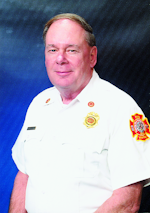
Robert Burke
Robert Burke, who is a hazardous materials and fire protection consultant and who served as a Firehouse contributing editor, is a Certified Fire Protection Specialist (CFSP), Fire Inspector II, Fire Inspector III, Fire Investigator and Hazardous Materials Specialist. He has served on state and county hazmat teams. Burke is the author of the textbooks "Hazardous Materials Chemistry for Emergency Responders," "Counter-Terrorism for Emergency Responders," "Fire Protection: Systems and Response," "Hazmat Teams Across America" and "Hazmatology: The Science of Hazardous Materials."
